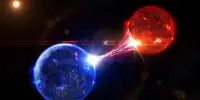Astronomers use observations of the universe’s large-scale structure, such as the distribution of galaxies, galaxy clusters, and cosmic microwave background radiation, to infer the presence and properties of dark matter.
New research has revealed the dispersion of dark matter in unprecedented clarity, down to a size of 30,000 light-years. The observed distribution fluctuations provide more information about the nature of dark matter.
The majority of matter in the Universe is made up of mysterious dark matter. Dark matter is invisible and only manifests itself through gravitational influences. Because dark matter has never been isolated in a laboratory, researchers must rely on “natural experiments” to investigate it.
New research has revealed the dispersion of dark matter in unprecedented clarity, down to a size of 30,000 light-years. The observed distribution fluctuations provide more information about the nature of dark matter.
A gravitational lens is one sort of natural experiment. When viewed from Earth, two objects at different distances in the Universe may, by coincidence, lie along the same line-of-sight. When this occurs, the spatial curvature generated by the matter surrounding the foreground object works as a lens, bending the path of light from the background object and producing a lensed image.
However, it is difficult to attain the high resolution required in natural tests to discover clumps of dark matter that are less massive than galaxies, hence the actual form of dark matter is unknown.
A team of Japanese researchers led by Professor Kaiki Taro Inoue at Kindai University used ALMA (Atacama Large Millimeter/submillimeter Array) to study the gravitational lens system known as MG J0414+0534 in the direction of the constellation Taurus.

The gravitational attraction of a giant galaxy acting on the light causes the foreground object to produce four pictures of the background object in this system. The team was able to detect oscillations in the dark matter distribution along the line of sight in higher resolution than ever before, down to a size of 30,000 light-years, thanks to the bending effect and their innovative data analysis method.
The observed distribution’s additional limitations are consistent with models of slow-moving, or “cold,” dark matter particles.
With additional observations in the future, the team hopes to further limit the nature of dark matter.
Some researchers explore alternative theories of gravity as an explanation for observed phenomena attributed to dark matter. These theories aim to modify the laws of gravity on large scales without introducing dark matter particles.















